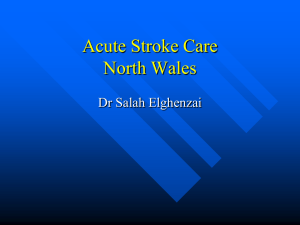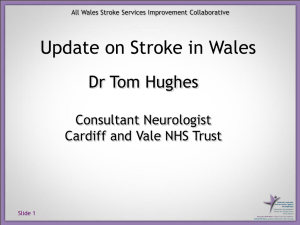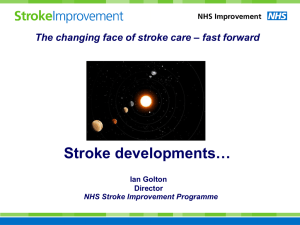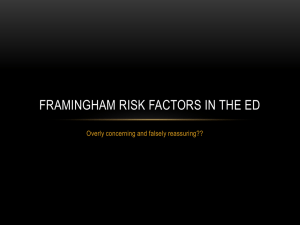August CE Angina, Acute MI, Stroke
advertisement
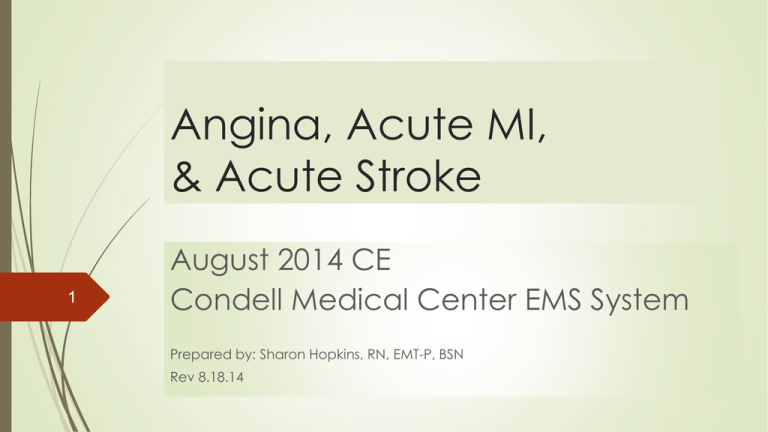
Angina, Acute MI, & Acute Stroke 1 August 2014 CE Condell Medical Center EMS System Prepared by: Sharon Hopkins, RN, EMT-P, BSN Rev 8.18.14 2 Objectives Upon successful completion of this module, the EMS provider will be able to: 1. Describe the pathophysiology of angina. 2. Describe the pathophysiology of the acute myocardial infarction process. 3. Describe the atypical presentations of women, elderly, and those with long standing diabetes. 3 Objectives cont’d 4. Describe the pathophysiology of ischemic and hemorrhagic strokes. 5. Describe field assessment of the patient with a possible stroke including documentation of time of onset, blood sugar level, and Cincinnati Stroke Scale. 6. Actively participate in review of selected Region X SOP’s. 4 Objectives cont’d 7. Actively participate in review of a variety of EKG rhythms and 12 lead EKG’s. 8. Actively participate in case scenario discussion. 9. Actively participate in calculating and preparing medication doses for the pediatric patient. 10. Review responsibilities of the preceptor role. 11. Successfully complete the post quiz with a score of 80% or better 5 Cardiovascular Anatomy Cardiovascular system has 2 major components Heart 4 chambered pump 2/3 of mass is to left of sternum Apex just above diaphragm Base, top of heart, lies at level of 2nd rib Peripheral blood vessels Transport system to deliver blood to the body and to transport waste for removal 6 Layers of the Heart Pericardium – protective sac around heart Epicardium - Outer most layer Coronary vessels lie on this epicardial layer Myocardium Thick middle layer of cells with electrical properties Endocardium - Inner most layer Lines heart chambers; in contact with blood flow within the chambers 7 Cardiac Damage Post MI Each individual is unique Damage may be only on the surface or penetrate all layers of the heart The greater the level/degree of damage to the heart the more negatively affected the heart is to work as a pump 8 Diagram of the Heart 9 What is Acute Coronary Syndrome (ACS)? A list of diagnoses that affect the cardiac system Indicates an interruption of blood flow to the heart Unstable angina Non-ST elevation MI ST elevation MI 10 What Causes ACS To Develop? An imbalance between supply and demand of O2 Atherosclerotic plaque rupture in coronary artery Thrombosis (clot) formation in artery Coronary spasm Dissection of blood vessel Increased demand of O2 in face of fixed obstruction 11 Main Contributing Risk Factors to Cardiac Problems Hypertension Hyperlipidemia Smoking Diabetes Notice: all of the above are considered modifiable risk factors – you can do something to control them! 12 Pathophysiology of angina Chest pain/discomfort related to a decrease in oxygen-rich blood flow Usually due to coronary artery disease (CAD) Atherosclerosis Build up of plaque over time that narrows the internal diameter of the vessel Arteriosclerosis Stiffening of vessels over a period of time which makes them less pliable Pathophysiology of Angina 13 Plaque formation Angina serves as a warning that something is going on Stable Angina 14 Most common form Pain occurs when oxygen demand is greater than the supply during periods of increased workload of the heart Can usually predict activities that will trigger an event Usually treated with rest and medication (i.e.: nitroglycerin) This is a warning that the patient may have an acute MI in the future 15 Unstable Angina Pain that is unpredictable and can occur at rest May not stop with rest and/or medication Event to be taken seriously May be predicting an imminent acute MI in the near future 16 Variant Angina Occurs when vessel is in spasm Very painful Often occurs at night Controlled with medication 17 Treating Angina Treated as if the patient were experiencing an acute MI Patient should stop activity and rest Question if the patient has taken their own nitroglycerin or other medication Often, if the pain is relieved with rest and nitroglycerin, it is usually angina, not acute MI 18 Pathophysiology of Acute MI Process Significant blockage of one or more coronary arteries Atherosclerosis is gradual process, typically over decades, of plaque build-up on arterial walls Size and area affected impacts outcome Location, location, location! Development of Blockage 19 20 Ischemic Cascade Heart cells around blocked coronary artery die These do not regenerate Collagen scar forms Scarring increases risks for potentially life-threatening dysrhythmias Weakened muscle walls vulnerable to formation of ventricular aneurysm which could rupture at any time Injured heart tissue conducts electrical impulses more slowly Allows for possible development of re-entry or feedback loop that can generate dysrhythmia 21 Pathological Types of Acute MI Transmural – atherosclerosis affected a major coronary artery MI extends through whole thickness of heart muscle Anterior, posterior, inferior, lateral, septal walls ST elevation noted on EKG and Q waves develop Subendocardial Small area below surface of wall involved in left ventricle, ventricular septum, or papillary muscle ST depression noted on EKG 22 Coronary Circulation Coronary arteries (CA) Vessels that originate in aorta Supply the heart with it’s blood flow Main CA lies on surface of heart – epicardial coronary arteries Small penetrating arteries supply myocardial muscle 23 Collateral Circulation Protective mechanism to provide alternative path for blood flow in case of system blockage Takes time to develop 24 Coronary Arteries Left coronary artery Left ventricle Interventricular septum Part of right ventricle Heart’s conduction system 2 branches Anterior descending artery (LAD) Circumflex artery 25 Coronary Arteries cont’d Right coronary artery Portion right atrium, right ventricle, and part of conduction system 2 branches posterior descending artery Marginal artery 26 STEMI Waveform Pattern Evaluation of ST segment elevation 0.04 seconds after J point >2mm for males in V2 and V3 >1.5mm females in V2 and V3 >1mm in other EKG leads Early STEMI may just display peaked T wave ST elevation develops later 27 Elements of AMI 28 Myocardium and Vessel Structure Notice that coronary arteries lie on epicardial surface 29 Patient Complaints and Evaluation Symptoms that persist beyond 15 minutes Remember that symptoms may be vague Always consider worse case scenario and hope for the best When in doubt, obtain a 12 lead EKG Remember: a negative 12 lead EKG does not mean the patient is NOT having an MI We are just positive when ST elevation is present 30 Mimics of Chest Pain Occurrences of chest pain must be fully evaluated Assume the worst; hope for the best Need to consider other differential diagnosis putting the one that is most life threatening at the top of the list Remember to not be fooled by atypical presentation of AMI 31 Differential Diagnosis …What Could This Be??? Stable angina Esophageal spasm Acute pericarditis Reflux Aortic dissection Gastritis Pulmonary embolism Cholecystitis Pneumonia Pancreatitis Pneumothorax Musculoskeletal pain 32 Non-atherosclerotic Causes AMI in Younger Patients Emboli from infected cardiac valves Congenital coronary anomalies Coronary occlusion from vasculitis Coronary trauma Coronary artery spasms Cocaine use Increased O2 requirement Decreased O2 delivery (i.e.: anemia) 33 Typical Patterns of Chest Pain May be from surge of catecholamines in response to pain and hemodynamic abnormalities from cardiac dysfunction Atypical Presentations 34 Women, elderly, long standing diabetics Back pain Jaw pain Right arm pain Indigestion Nausea Fatigue/weakness Dyspnea/ shortness of breath No pain Atypical Presentation in Women 35 Most frequent complaints in women are shortness of breath, weakness, feeling of indigestion, and fatigue 36 Women and Acute MI What causes atypical presentations? Anatomical factors Physiological factors Pathological factors The above list may demonstrate the causes of the differences between males and females in typical versus atypical presentation of acute MI 37 Atypical Presentations of Elderly Most likely complaints Dyspnea Diaphoresis Nausea Syncope May have atypical presentation most likely due to altered pain perceptions 38 Atypical Presentation of Long Standing Diabetes Silent ischemia considered due to autonomic denervation of heart Nerve damage that disrupts signals between the brain and other body parts Diabetics recognized at risk for atherosclerotic plaque formation and thrombosis contributing to acute MI 39 Diagnosing Cardiac Problems Patient history of events 12 lead EKG analysis – changes over hours & days Large peaked T waves, then ST elevation, then negative T waves, then pathological Q wave development Cardiac markers – blood work Timing of the rise and fall of enzymes can help predict when the acute process occurred Troponin I levels Specific to myocardial damage 40 Cardiac Markers 41 Have you ever wondered… What will I see on the EKG if the patient is having angina and not an MI? ST elevation can occur (rarely) if perfusion is poor or some spasm is present; it could take some time for the ischemia to normalize When ST elevation on EKG is from a paced rhythm or LBBB, how do you decide when to take the patient to the cath lab? Most often history and how the patient looks are deciding factors. Cardiologists would rather find normal arteries than miss an MI. Comparison with old EKG’s could help if they are available 42 Questions cont’d…. If the patient is having atypical angina attacks, what is the likelihood that they will have an acute MI? This is very predictive with a rate of at least 30% within 30 days Do all persons with an MI develop a diagnostic Q wave that shows on the EKG forever? Diagnostic Q waves do not develop immediately and may not if response and repair is rapid. They depend on the thickness of the infarct and length of time before treatment 43 Delay in Seeking Care Atypical presentations (absence of chest pain) increase the delay before seeking care TIME IS MUSCLE!!! Delay in appropriate assessment and intervention increases the mortality rate 44 What Therapies Are Available for Diagnosing and Treating AMI? Angiogram / Cardiac catherization Insertion of long flexible tube into artery or vein Die injected to evaluate blood flow through coronary arteries Fibrinolytic therapy Medication used to dissolve the clot 45 Therapies cont’d Angioplasty / PTCA Percutaneous transluminal coronary angioplasty Balloon tipped catheter introduced into femoral artery Advanced to coronary artery Balloon expanded to press clot into wall of artery Stent may be left to keep lumen open “Door-to-balloon” phrase often heard 46 Therapies cont’d CABG / “open heart” Coronary artery by-pass graft surgery Small vein removed from the patient (i.e.: leg) and attached to the aorta and then a point beyond and by-passing the blockage 47 Angiogram With Severe LAD Stenosis 48 Stent Placement in LAD 49 LBBB Pattern & Paced Rhythms in Acute MI Diagnosis difficult based on the EKG The baseline ST segments and T waves shift masking or mimicking acute MI Assume acute MI and treat as such Hospital assessment includes lab analysis and MD assessment Patients may be taken to the cath lab on presumptions MD would rather err on side of being aggressive than to be delayed in treatment of acute process 50 LBBB Pattern on 12 Lead EKG 51 Paced Rhythm 12 Lead EKG 52 Region X SOP – Adult ACS Adult Routine Medical Care Obtain 12 lead EKG and contact Medical Control for STEMI alert if ST elevation noted Note: contact Medical Control first if ST elevation in II, III, aVF (inferior wall MI) prior to administration of nitroglycerin and morphine Patient susceptible to episode of hypotension 53 ACS SOP cont’d Determine if patient is stable or unstable What is the level of consciousness? What is the blood pressure? What are the skin parameters? If unstable, limit medication to aspirin 324 mg chewed, if patient can tolerate Consider IV/IO fluid challenge in 200 ml increments Early contact with Medical Control important 54 ACS SOP cont’d If patient is stable Aspirin 324 mg chewed If chest pain, Nitroglycerin 0.4 mg sl Screen for MI location, B/P, Viagra-type use previous 24-480 May repeat every 5 minutes as needed Maximum of 3 doses Manage pain appropriately Morphine 2 mg IVP over 2 minutes May repeat every 2 minutes to a maximum total dose of 10 mg 55 Aspirin Extremely important One of the single most important interventions that reduces morbidity and mortality Prevents platelet aggregation to site of fractured plaque Prevents increase in degree of blockage to blood flow Better to have patient take an extra dose than to totally miss any coverage with aspirin 56 Development of a Stroke Clots, plaques, & hemorrhage causing problems 57 2 Main Types of a Stroke Ischemic – the more common (83%) Blockage of blood flow in a vessel Thrombotic stroke – blockage by blood clot development in artery supplying brain Embolic stroke - blood clot from another area of body travels to brain and blocks blood flow Atrial fib most common cause Hemorrhagic – more deadly (17% occurrence) Tearing or rupture of a weakened vessel Blood spills into or around the brain 58 Pathophysiology of Stroke Ischemic (blockage) versus hemorrhagic 59 Major Risk Factors for Stroke Atherosclerosis High cholesterol levels Hypertension Diabetes Smoking 60 Additional Risk Factors Leading to Stroke Obesity Alcohol consumption Substance abuse – particularly cocaine Oral contraceptive use Sickle cell disease Atrial fibrillation rhythm Sedentary habits promoting development of deep vein thrombosis (DVT) Surgery, lengthy travel, immobility due to casting 61 Ischemic Stroke Symptoms Similar to TIA but damage can be permanent Dependent on area & size of brain affected Most common symptom: sudden unilateral weakness face, arm, and/or leg Sudden confusion, trouble speaking/understanding Sudden visual changes Sudden trouble walking, dizziness, loss of balance or coordination 62 Hemorrhagic Stroke Symptoms Rupture can be from high blood pressure or cerebral aneurysm Location of hemorrhage, not amount of bleeding, influences severity of stroke Intracerebral – bleeding within the brain Hypertension most common cause Blood vessel abnormalities (AVM, AVF) can cause pressure on tissue or rupture Subarachnoid hemorrhage Bleeding between brain and skull Most common complaint – severe headache! 63 Arteriovenous Malformations - AVM Masses of arteries and veins without intervening capillaries Vessels dilate and often twist Tend to be congenital & near back of brain High pressured arterial blood flow of arteries empty directly into thin walled veins Stress can cause rupture of vessel Exchange of oxygen and nutrients hampered Normally occurs via system of capillary walls 64 Arteriovenous Fistulas - AVF Can be congenital but more often caused by trauma that damages an artery and a vein lying side by side in the brain Artery and vein join together losing the protective separation of capillary system AVM and AVF problems Hemorrhage into surrounding tissues Pressure on adjacent part of brain creating neurological deficits 65 General Treatment AVMs and AVFs Surgery to tie off or clip arterial vessels that feed the abnormality Endovascular embolization Injection of agent to block blood flow through abnormal connection (i.e.: special glue, coil, balloon) Radiosurgery External beams of radiation to injure or clog the abnormality – can take weeks/years and can damage surrounding tissue 66 Hospital Diagnosing of a Stroke Confirm the problem is an acute stroke Eliminate other possibilities Determine type of stroke – ischemic or hemorrhagic 3 dimensional imaging (CT scan, MRI) and other specialized testing processes Determine time of onset, location and severity of stroke Dictates treatment approach 67 Field Assessment of Possible Stroke Maintain high index of suspicion!!! Not all stroke presentations are clear cut!!! Blood glucose level to rule out other issues Cincinnati Stroke Scale Facial droop – right, left, none Arm drift – right, left, none Speech – clear, not clear Did we mention maintain high index of suspicion??? Hospital Treatment of Stroke 68 Goal – remove blockage and restore blood flow Thrombolytic drug therapy – tPA (clot-buster) Short window of time to deliver (3-41/2 hours from onset) incidence of intracranial bleeding after this time Mechanical device on end of catheter to pull out all or part of clot Requires specialized surgery and practitioner Administer antiplatelet meds (i.e.: aspirin) Maintain normal blood sugar levels Abnormal levels can aggravate stroke damage 69 Region X SOP Treatment - Stroke Adult Routine Medical Care Determine time of onset of symptoms Referred to as “last known normal” Obtain blood glucose level Treat if level <60 Perform Cincinnati Stroke Scale Record specific abnormal responses in the narrative Box provided in Image Trend only allows normal/abnormal comment 70 Stroke SOP cont’d Contact Medical Control Needs early notification to prepare timely response If rapid neurological deterioration, ventilate pt 1 breath every 3 seconds Document 20/minute assisted for respiratory rate Consider Drug Assisted Intubation if needed 71 Treatment Stages for Stroke Prevention Behavior modification & lifestyle changes Use of anticoagulants/blood thinners Prevents clot formation or growth; does not dissolve clots already formed Intervention during acute phase Intensive care immediately after Rehabilitation Physical , occupational, speech, audiology therapies as an in or out patient basis 72 Stroke Outcomes 10% stroke survivors recover almost completely 25% recover with minor impairments 40% recover with moderate to severe impairment Will require special care 10% will require care in nursing home or other long-term care facility 15% die shortly after the stroke 73 Patient Role in Stroke Care Recognition of signs and symptoms of a stroke Important role of the healthcare worker to educate the public on this information Activating 911 without delay Minimizing risk factors by adopting healthier life style choices 74 EMS Role in Stroke Care Determine general impression keeping high index of suspicion for stroke Perform appropriate physical exam Obtain adequate history Transport to closest appropriate hospital with minimal delay Providing early report allows receiving facility to be prepared – clock is ticking! TIME IS BRAIN!!! 75 Obtaining Pre-hospital 12 Lead EKG’s Many patients will be monitored for their baseline rhythm Not all patients monitored require a 12 lead EKG Any 12 lead EKG obtained must be interpreted and transmission attempted to the receiving facility, if capable 76 12 Lead EKG’s When in doubt, obtain a 12 lead EKG Silent MI’s do occur The patient has absolutely no complaints of pain Any complaints will most likely be very vague Absence of ST elevation (non-diagnostic EKG) does not mean the patient has no cardiac issue going on Maintain high level of suspicion based on clinical presentation and history of present illness 77 Case Scenario #1 37 y/o male crushing chest pain over the sternum Cool/clammy, anxious VS: B/P 90/58; P – 124; R – 26; SpO2 96%; pain 3/10 EKG monitor attached Your general impression? Acute MI until proven otherwise Differential should include other cardiac problems, respiratory problems, GI problems ALWAYS go for the worst case scenario!!! Case Scenario #1 – What’s this rhythm? 78 Sinus tachycardia What other assessments need to be obtained that help narrow down a general impression? 12 lead EKG Head-to-toe hands-on assessment especially of cardiac and respiratory systems 79 Case Scenario #1 What interventions have been started? Vital signs, pulse ox, pain scale Preparation to obtain 12 lead EKG Aspirin to chew if no contraindications Hold nitroglycerin until B/P, 12 lead EKG reviewed and history verified of no Viagra type drug use last 24-480 ST elevation in inferior wall (leads II, III, aVF) would prompt restriction of therapies that would trigger vasodilation responses 80 Case Scenario #1 – Reassessment VS: B/P 100/60; P – 106 irregular; R – 22; SpO2 97% RA; pain 2/10; lungs remain clear What is the rhythm? Sinus rhythm with multifocal PVC’s 81 Case Scenario #1 - Reassessment Do you treat the rhythm? Monitor for now FYI: PVC’s common dysrhythmia in COPD & cardiac irritability; they don’t all need to be treated VS: B/P 106/64; P - 98 reg; R – 22; SpO2 98% RA VS: B/P 110/70; P – 72 reg; R – 16; SpO2 100% RA; pain 0/10 82 Case Scenario #2 55 y/o female presents with weakness in right arm starting 1 hour ago Appears shaky and scared; warm and dry Hx: elevated cholesterol levels, mild hypertension VS: B/P 160/92; P – 88; R – 18; SpO2 99% RA What is your general impression and what assessments or interventions would be done? 83 Case Scenario #2 General impression to consider Acute stroke high on the list Could be anxiety, slept funny, resting arm in awkward position Can you rule out stroke based on patient age and absence of risk factors? NO! Young children can have strokes Usually different etiology than older adults Case Scenario #2 84 Can symptoms predict part of brain affected? Yes Frontal lobe – planning, problem solving, personality, higher cognitive functions Parietal lobes – touch, pressure, fine sensation Lt parietal – expressive/receptive aphasia Rt parietal – visuo-spacial deficits Hard to find way around even familiar surroundings Temporal lobes – smells and sounds; short term memory Occipital lobe – processing visual information 85 Case Scenario #3 69 y/o female c/o intermittent SOB several days Alert, tired looking, lightheaded, increased fatigue, poor appetite, nausea Hx: Hypertension, cholesterol, GERD; ½ PPD smoker x20 yrs (has quit) VS: B/P 170/80; P – 80; R – 16; SpO2 96% RA Lungs clear; abdomen soft, non-tender 86 Case Scenario #3 What is the rhythm strip? Sinus rhythm with 1 PAC Would you obtain an EKG? You should; vague cardiac presentations common in woman and elderly Case Scenario #3 – EKG Interpretation? 87 Normal – no ST elevation noted (or ST depression) 88 Case Scenario #3 If an EKG is normal (i.e.: lacks ST elevation), does this mean the patient for sure is not having an acute MI? No; patient should still be treated for ACS ASA NTG if applicable Morphine if necessary Case Scenario #3 89 Suddenly, the patient becomes unresponsive Now what do you do??? Assess the patient; look at the monitor while checking for a pulse What’s the rhythm? Torsades (pulseless VT) There is no pulse – now what??? Prepare to defibrillate and begin CPR 90 Case Scenario #3 What therapies are necessary running this code? Defibrillation attempts every 2 minutes Immediate return to CPR with compressions Epinephrine 1 mg IVP/IO every 3-5 minutes Alternate Epi with Amiodarone 300 mg IVP/IO first dose 150 mg IVP/IO repeated dose Common Therapies to Prevent Future AMI 91 Anti-platelet therapy Aspirin and/or Plavix Beta-blocker Decrease workload of heart Meds end in “olol” ACE-inhibitors development of heart failure Meds end in “pril” Statin therapy To lower LDL levels of cholesterol 92 Case Scenario #4 78 y/o male presents with weakness and dizziness; complains of inability to get out of bed Hx: Hypertension, gout, diabetes, MI x2 with hx CABG 3 years ago Alert and oriented; responding to all questions VS: B/P 172/86; P – 150 irregular; R – 20; SpO2 96% RA; denies pain; lungs clear What is your general impression? 93 Case Scenario #4 General impression? Effects of feeling “under the weather” Stroke Silent MI Dehydration Natural aging process Could be anything and nothing 94 Case Scenario #4 What’s the rhythm? Rapid atrial fibrillation What are the risks to this patient? Atrial fibrillation causing a stroke from emboli in atria 95 Case Scenario #4 What are the greatest risk factors for stroke? Atherosclerosis High cholesterol levels Hypertension Diabetes Smoking 96 Case Scenario #4 If this were a stroke, what are the important points of assessment & care for EMS to provide? Assessment Time of last known normal Blood sugar level Cincinnati Stroke Scale Interventions Rapid identification and rapid transport Early report called to receiving facility Monitor the rapid heart rate – no interventions for now 97 Medication Preparation for Pediatric Patients CE for September will be running a code for the pediatric patient In preparation, review math calculations for the pediatric patient this month Practice reading the SOP’s for orders, following the pediatric medication charts in the SOP’s, and comparing information with the Broselow tape 98 Pediatric Medication Calculation Determine the proper dosing for the following situations Be prepared to draw up different volumes of pediatric doses Compare answers listed in the SOPs with those listed on the Broselow tape 99 Check the SOP’s and Broselow for dosing and compare answers: Amiodarone for 55# Versed for 80# Fentanyl for 60# Glucagon for 65 # Narcan for 90# Valium for 35# Epinephrine 1:10,000 for 40# Zofran for 30# 100 Pediatric Medication Calculation Region X SOP Amio 24 kg – 2.4ml/120mg Broselow Tape Amio – orange – 130mg Midazolam – green - 10mg Versed 36kg – 0.72ml/3.6mg Fentanyl–orange–80 mcg Fentanyl 26kg – 0.26ml/13mcg Glucagon – orange - 1mg Glucagon 28kg – 1ml/1mg Naloxone –up to 36 kg Narcan 40kg – 2ml/2mg Diazepam – white - 3.3mg Valium 16kg – 0.64ml/3.2mg Epi1:10,000-white Epi 1:10,000 18kg – 1.8ml/0.18mg 1.7ml/0.17mg Zofran 12 kg – 0.6ml/1.2mg Zofran-yellow-not listed 101 Pediatric Medication Calculation Why the difference in dosing from the Region X SOP’s and Broselow tape? Each group may use a different formula for the medication Often medication dosing is provided in ranges Example: 1 – 3 mg/kg Reminder: Region X SOP – go to the next lowest/closest weight listed in charts Can always give more if needed 102 Region X SOP Resource vs Broselow Tape Region X SOP provides “ml” for filling the syringe AND “mg” for documentation Broselow tape often provides only “mg” Still need to calculate the “ml” to fill the syringe Region X SOP medication charts list trade and generic names Broselow tape often uses only 1 medication name (i.e.: Diazepam, Naloxone, Midazolam, crystalloid fluids 103 Preceptor Role Provides a guide to transition and integration into the workforce Supports development of clinical competence and confidence for growth of a professional healthcare provider Sharing skills and knowledge assures the development of others to continue to provide superior care in an increasingly complex care environment Must be supported by all in the workplace 104 Bibliography Bledsoe, B., Porter, R., Cherry, R. Paramedic Care Principles & Practices, 4th edition. Brady. 2013. Mistovich, J., Karren, K. Prehospital Emergency Care 9th Edition. Brady. 2010. Region X SOP’s; IDPH Approved April 10, 2014. http://www.merckmanuals.com/professional/neurologic _disorders/spinal_cord_disorders/overview_of_spinal_cor d_disorders.html http://lifeinthefastlane.com/ecg-library/basics/leftbundle-branch-block/ http://www.interactive-biology.com/75/show-me-adiagram-of-the-human-heart-here-are-a-bunch/ 105 Bibliography cont’d https://sites.google.com/site/caduceusnewsletter/medi cal-reference/myocardial-infarction---by-cornelia-riedl http://www.clevelandclinicmeded.com/medicalpubs/di seasemanagement/cardiology/complications-of-acutemyocardial-infarction/ http://www.uhnj.org/stroke/types.htm http://floatnursemike.blogspot.com/2012_10_01_archive.html
